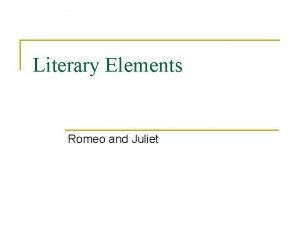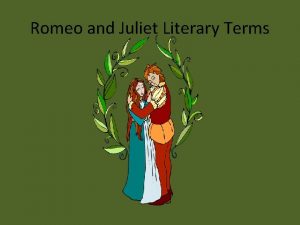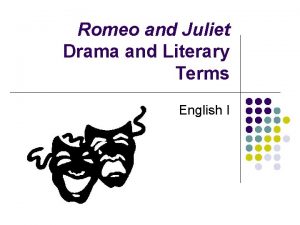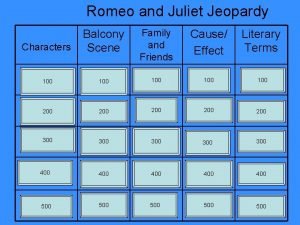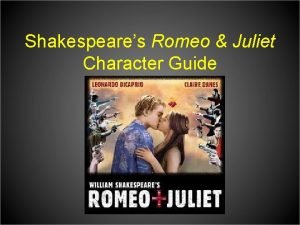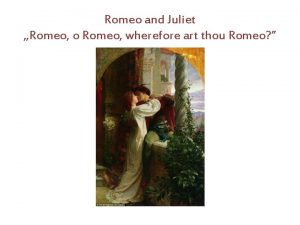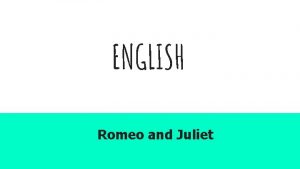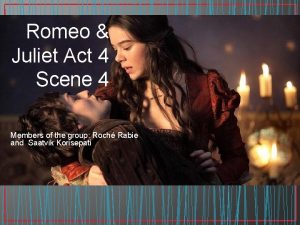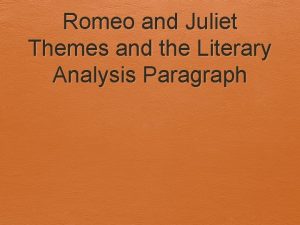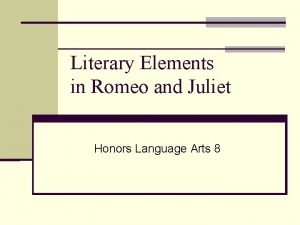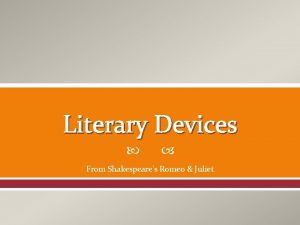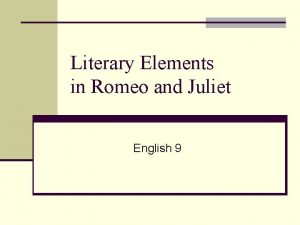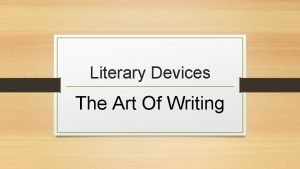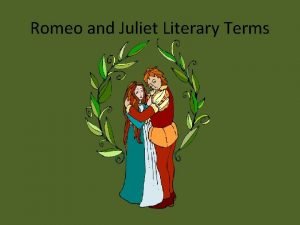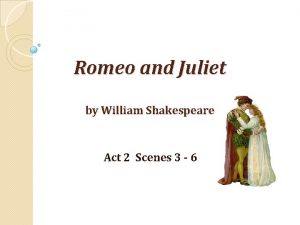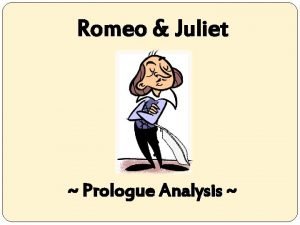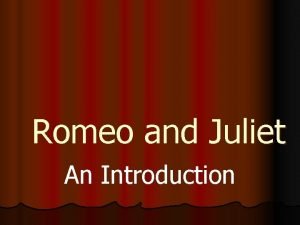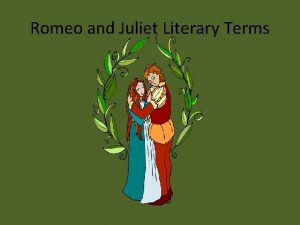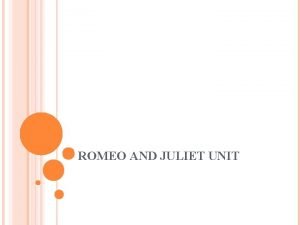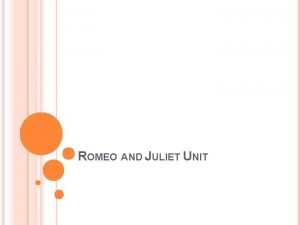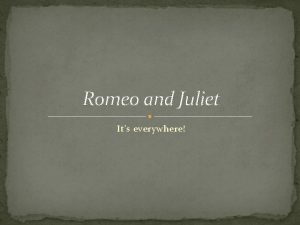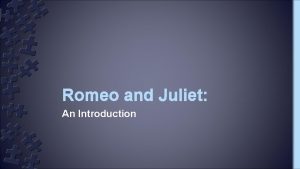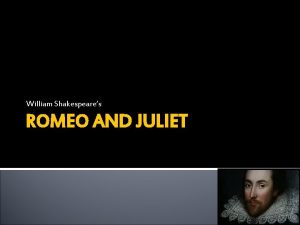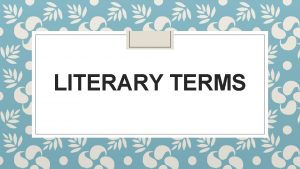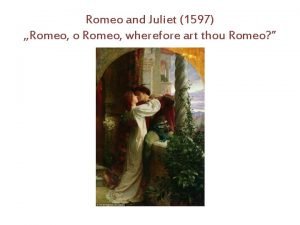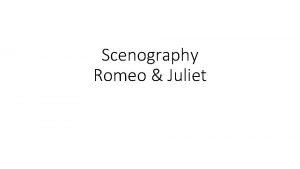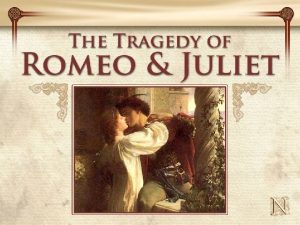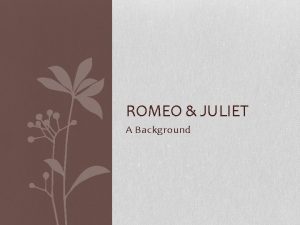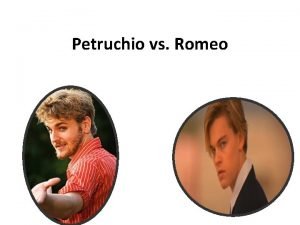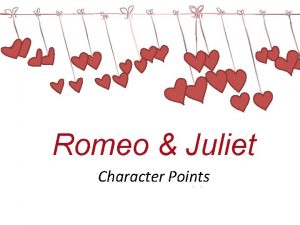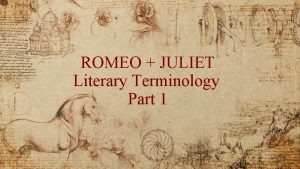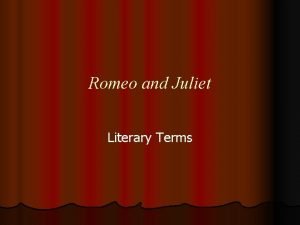Romeo and Juliet Literary Terms Setting Setting a




















- Slides: 20

Romeo and Juliet Literary Terms

Setting • Setting: a story’s time, place, and background. • Romeo and Juliet probably takes place around 1200 or 1300 A. D. , when Italian families were feuding.

Figurative Language • Figures of Speech: Specific tools writers use to paint "word pictures. “ • Example: Juliet uses the sea as a simile to help Romeo understand how much she loves him: “My bounty is as boundless as the sea, My love as deep; the more I give to thee, The more I have, for both are infinite. " (2. 2. 133 – 136)

Inference • Inference: To reason from circumstance; surmise. • Example: It appears that Friar sees men and women in their traditional perspectives. In Act II, scene iii, Friar says this about Romeo: Young men's love then lies Not truly in their hearts, but in their eyes.

Foreshadowing • Foreshadowing: events which hint of things to come • Example: In the Prologue to Act 1, the Chorus foreshadows what will happen in the play. One thing that will happen is that a feud will be renewed violently, as “civil blood makes civil hands unclean” (4).

Oxymoron • Oxymoron: bringing together two contradictory terms • Example: In Act 1, Scene 1, line 181, Romeo uses several oxymora (the plural of “oxymoron”) to describe the relationship of love and hate. He says, “O brawling love, O loving hate. ”

Allusion • Allusion: reference to historical or literary figure, event, or object • Example: In Act 1, Scene 1, line 217, Romeo says that Rosaline “hath Dian’s wit. ” He is alluding to Diana, goddess of chastity, who opposed love and marriage. In other words, Rosaline thinks like Diana and will not fall in love with Romeo.

Imagery • Imagery: representation in words of a vivid sensory experience • Example: In Act 1, Scene 5, lines 55 and 56, Romeo uses imagery to describe Juliet’s beauty when he says, “So shows a dove trooping with crows / As yonder lady o’er her fellows shows. ”

Metaphor • Metaphor: an implied comparison between two unlike things, without “like” or “as”. • Example: In Act 2, Scene 2, line 3, Romeo uses a metaphor, saying, “Juliet is the sun, ” meaning that Juliet is bright and beautiful.

Soliloquy • Soliloquy: a speech an actor gives as though talking to himself or herself • Example: Romeo starts his famous soliloquy about Juliet with the words, “But soft, what light through yonder window breaks” (II. ii. 2). He is speaking to himself about Juliet.

Simile • Simile: a direct comparison of unlike things using “like” or “as” • Example: In Act 2, Scene 6, lines 8 -10, Friar Lawrence uses a simile to warn Romeo about being too passionate too soon. He says: “These violent delights have violent ends And in their triumph die, like fire and powder, Which, as they kiss, consume. ”

Protagonist • Protagonist: the main character in a piece of literature • Example: In this play, Romeo is the protagonist.

Antagonist • Antagonist: the person or force opposing the main character • Example: Tybalt is one antagonist in the play.

Theme • Theme: the main idea of a piece of literature • Example: One theme of Romeo and Juliet might be that “haste makes waste. ” In other words, hurrying too much often leads to problems.

Personification • Personification: When a non-human is given human characteristics • Example: Romeo says: "Arise, fair sun and kill the envious moon"

Dramatic Irony • Dramatic irony, a situation where the reader knows more than the characters do • Lady Capulet's misunderstanding of Juliet's feelings is ironic. She believes Juliet is "evermore weeping for [her] cousin's death, " when she sees her sorrow. The reader knows she’s weeping for Romeo.

Sonnet • William Shakespeare wrote 154 sonnets. • A sonnet, a form of poetry invented in Italy, has 14 lines with a specific rhyme scheme. • The topic of most sonnets written in Shakespeare's time is love–or a theme related to love.

Rhyme Scheme In Shakespeare’s sonnets, the rhyme scheme is as follows: . . . First stanza (quatrain): ABAB . . . Second stanza (quatrain): CDCD . . . Third stanza (quatrain): EFEF . . . Couplet: GG.

Iambic Pentameter • iambic pentameter, with stresses regularly punctuating every other syllable. A line of iambic pentameter is five iambic feet in a row: da DUM da DUM • ~ / ~ / But, soft! what light through yonder window breaks?

Rhyming Couplets When two rhyming lines are found together, this is called a rhyming couplet. • Found in the last two lines of a sonnet. • Used to emphasize a point.
 A long uninterrupted speech by one character
A long uninterrupted speech by one character Alliteration examples in romeo and juliet
Alliteration examples in romeo and juliet Metaphor of romeo and juliet
Metaphor of romeo and juliet Long uninterrupted speech
Long uninterrupted speech Prompt book romeo and juliet
Prompt book romeo and juliet Romeo and juliet family names
Romeo and juliet family names Romeo's character traits
Romeo's character traits Oh romeo my romeo
Oh romeo my romeo Romeo and juliet important quotes
Romeo and juliet important quotes Literary devices in act 4 scene 4 romeo and juliet
Literary devices in act 4 scene 4 romeo and juliet Romeo and juliet topic sentence
Romeo and juliet topic sentence Literary devices in romeo and juliet
Literary devices in romeo and juliet Simile for romeo and juliet
Simile for romeo and juliet Literary devices romeo and juliet
Literary devices romeo and juliet Literary devices in romeo and juliet
Literary devices in romeo and juliet Literary techniques in romeo and juliet
Literary techniques in romeo and juliet Similes in romeo and juliet act 1
Similes in romeo and juliet act 1 How to cite romeo and juliet
How to cite romeo and juliet Romeo and juliet act ii scene ii
Romeo and juliet act ii scene ii Prologue of romeo and juliet analysis
Prologue of romeo and juliet analysis Setting of romeo and juliet
Setting of romeo and juliet

